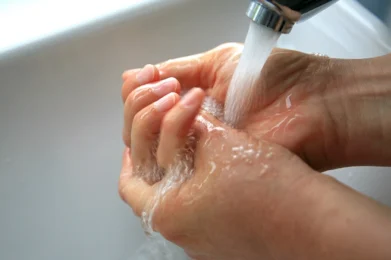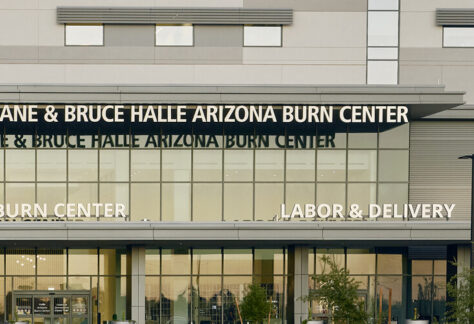In This Article:
- Arizona is now entering its 26th year of a long-term drought, with 99% of the state experiencing some sort of water shortage and 87% in extreme drought.
- If the water shortage in Arizona continues, we may see many negative health implications, including food shortages, infectious diseases and more.
- You can save water and help reduce the burden on our state by doing simple things around the house, like checking for leaks and taking shorter showers.
As desert residents, we’re no strangers to a dry climate. But as the water shortage in Arizona becomes more severe, we may start to see its impacts on not only our environment, but also our health. Here’s what you need to know about the water crisis, its negative effects on your wellbeing and how we can work together to conserve, protect and improve the future of the Valley.
Drought Status in Arizona
Arizona is now entering its 26th year of a long-term drought, with 99% of the state experiencing some sort of water shortage and 87% in extreme drought. Ninety-two percent of the Western U.S. is facing the same problem, while five years ago only 61% of the region was facing effects of water scarcity. Many claim the West is heading toward a megadrought, or full-on water crisis, in which Arizona would be the worst-affected state.
However, local water suppliers and government agencies have invested millions into finding solutions, from utilizing groundwater to importing water from other states. Rumors of Arizona running out of water have been around for decades, and so far, we’ve been able to overcome these challenges. We’ve implemented conservation programs, passed dozens of water-saving policies and developed long-term conservation plans. Hopefully, the same will be the case as we approach this “megadrought” – but if not, here’s what you can expect in terms of your health.
Health Effects of Water Scarcity
Water Quality
It’s important to note that a drought doesn’t just mean less water — it also means poorer quality water. As rainfall declines, many bodies of water may become stagnant and full of pollutants. This process is accelerated and amplified by Arizona’s high temperatures, which lead to reduced oxygen levels. Runoff from drought-related wildfires can also bring harmful sediment and debris to our water sources, killing fish and other aquatic life and reducing the overall quality of our water.
Food and Nutrition
The less rainfall we receive, the fewer crops our farmers can grow. What does this mean for you? If the drought continues, you’ll start to see even higher food prices, more shortages and less produce diversity. Extreme drought can also create a climate that shortens the growing season and leads to insect and disease infestation in many crops. Plus, the livestock we depend on for protein may become malnourished and diseased and die.
Infectious and Chronic Diseases
Did you know droughts can directly lead to an increase in infectious diseases? When rainfall is minimal, viruses and bacteria can pollute both groundwater and surface water. Those who have underlying health conditions or source their water from private wells are most prone to experience this effect of water scarcity. E. coli and Salmonella can also contaminate your food, as farmers are forced to resort to recycled water when irrigating their fields. In addition, stagnant water creates the perfect breeding ground for mosquitoes that carry diseases such as West Nile Virus.
Changes in water quality have a negative effect on those with compromised immune systems, and food insecurity is also associated with higher risks of diabetes and high blood pressure. A lack of safe drinking water can intensify pre-existing renal diseases and other chronic illnesses, as well.
Air Quality
Phoenix already has the fifth-worst air quality of all U.S. cities, but the water shortage in Arizona may lead to more extreme pollution. Dry and dusty weather often creates wildfires, which increase the amount of pollen, smoke particulates and harmful chemicals in the air. These particles irritate the bronchial passages and lungs, making people with asthma and other chronic respiratory illnesses more subject to complications. They also contribute to acute conditions, like bronchitis and bacterial pneumonia.
Lifestyle Risks
If water sports are your favorite way to stay active, you may be at increased risk for waterborne disease from bacteria, protozoa and other contaminants. Not to mention, decreasing water levels that may not be visible to the naked eye, such as rocks and debris, give you a greater chance of injury when boating, swimming or fishing.
How Can I Help Save Water?
To mitigate the effects of water scarcity, it will take a joint effort from both environmental organizations and the general public. Although it may not seem like you alone can make a difference, if we all cut back on our water use, we will start to see improvements. Here are some easy ways you can reduce and conserve water at home:
- Take shorter showers and consider installing water-saving or flow-restricting shower heads.
- Turn the water off when brushing your teeth.
- Keep your dishwasher and washing machine on the shortest cycles, and only run full loads.
- Water your lawn, plants and trees only when absolutely necessary or replace your grass with xeroscaping or desert landscaping.
- Check for water leaks throughout your home from sprinkler heads, pipes and faucets.







